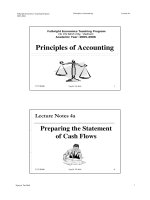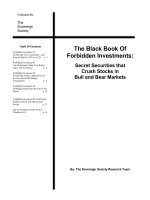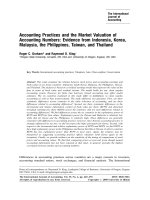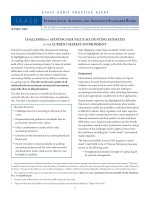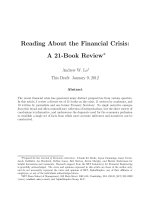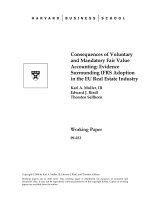The handy accounting answer book (the handy answer book)
Bạn đang xem bản rút gọn của tài liệu. Xem và tải ngay bản đầy đủ của tài liệu tại đây (15.15 MB, 416 trang )
www.ebook3000.com
www.ebook3000.com
www.ebook3000.com
About the Author
Amber K. Gray is a full-time accounting professor at Adrian College in Adrian, Michigan. She earned her bachelor’s degree in
business administration and master of science degree in accountancy from Western Michigan University. Gray currently
serves on the Accounting Educators Task Force of the Michigan Association of Certified Public Accountants and is a member of the Institute of Management Accountants Educational
Case Journal Editorial Advisory and Review Board. Prior to becoming a full-time accounting educator, Gray worked in public
accounting and held various titles in corporate accounting such
(photo by Darby Bullinger)
as accounting manager, assistant controller, and controller. During her time teaching at Adrian College, Gray earned the
“Teacher of the Year” award and has been an honored guest at several leadership appreciation events. She has been published in the International Journal of Business and Applied Social Science and has presented at conferences and other events on behalf of the
Michigan Association of Certified Public Accountants.
iii
www.ebook3000.com
www.ebook3000.com
www.ebook3000.com
A LSO
FROM
V ISIBLE I NK P RESS
The Handy African American History Answer
Book
by Jessie Carnie Smith
ISBN: 978-1-57859-452-8
The Handy American Government Answer
Book: How Washington, Politics, and
Elections Work
by Gina Misiroglu
ISBN: 978-1-57859-639-3
The Handy American History Answer Book
by David L. Hudson Jr.
ISBN: 978-1-57859-471-9
The Handy Anatomy Answer Book,
2nd edition
by Patricia Barnes-Svarney and Thomas E.
Svarney
ISBN: 978-1-57859-542-6
The Handy Answer Book for Kids (and
Parents), 2nd edition
by Gina Misiroglu
ISBN: 978-1-57859-219-7
The Handy Art History Answer Book
by Madelynn Dickerson
ISBN: 978-1-57859-417-7
The Handy Astronomy Answer Book,
3rd edition
by Charles Liu
ISBN: 978-1-57859-419-1
The Handy Bible Answer Book
by Jennifer R. Prince
ISBN: 978-1-57859-478-8
The Handy Christianity Answer Book
by Steve Werner
ISBN: 978-1-57859-686-7
The Handy Civil War Answer Book
by Samuel Willard Crompton
ISBN: 978-1-57859-476-4
The Handy Communication Answer Book
By Lauren Sergy
ISBN: 978-1-57859-587-7
The Handy Diabetes Answer Book
by Patricia Barnes-Svarney and Thomas E.
Svarney
ISBN: 978-1-57859-597-6
The Handy Dinosaur Answer Book,
2nd edition
by Patricia Barnes-Svarney and Thomas E.
Svarney
ISBN: 978-1-57859-218-0
The Handy English Grammar Answer Book
by Christine A. Hult, Ph.D.
ISBN: 978-1-57859-520-4
The Handy Forensic Science Answer Book:
Reading Clues at the Crime Scene, Crime
Lab, and in Court
by Patricia Barnes-Svarney and Thomas E.
Svarney
ISBN: 978-1-57859-621-8
The Handy Geography Answer Book,
3rd edition
by Paul A. Tucci
ISBN: 978-1-57859-576-1
The Handy Biology Answer Book, 2nd edition The Handy Geology Answer Book
by Patricia Barnes-Svarney and Thomas E.
by Patricia Barnes Svarney and Thomas E.
Svarney
Svarney
ISBN: 978-1-57859-156-5
ISBN: 978-1-57859-490-0
The Handy Boston Answer Book
by Samuel Willard Crompton
ISBN: 978-1-57859-593-8
The Handy History Answer Book, 3rd edition
by David L. Hudson, Jr., J.D.
ISBN: 978-1-57859-372-9
The Handy California Answer Book
by Kevin Hile
ISBN: 978-1-57859-591-4
The Handy Hockey Answer Book
by Stan Fischler
ISBN: 978-1-57859-513-6
The Handy Chemistry Answer Book
by Ian C. Stewart and Justin P. Lamont
ISBN: 978-1-57859-374-3
The Handy Investing Answer Book
by Paul A. Tucci
ISBN: 978-1-57859-486-3
www.ebook3000.com
The Handy Physics Answer Book,
2nd edition
by Paul W. Zitzewitz, Ph.D.
ISBN: 978-1-57859-305-7
The Handy Islam Answer Book
by John Renard, Ph.D.
ISBN: 978-1-57859-510-5
The Handy Law Answer Book
by David L. Hudson, Jr., J.D.
ISBN: 978-1-57859-217-3
The Handy Literature Answer Book: An
Engaging Guide to Unraveling Symbols,
Signs, and Meanings in Great Works
By Daniel S. Burt, Ph.D., and Deborah G.
Felder
ISBN: 978-1-57859-635-5
The Handy Presidents Answer Book,
2nd edition
by David L. Hudson
ISB N: 978-1-57859-317-0
The Handy Psychology Answer Book,
2nd edition
by Lisa J. Cohen, Ph.D.
ISBN: 978-1-57859-508-2
The Handy Math Answer Book, 2nd edition
by Patricia Barnes-Svarney and Thomas E.
Svarney
ISBN: 978-1-57859-373-6
The Handy Religion Answer Book,
2nd edition
by John Renard, Ph.D.
ISBN: 978-1-57859-379-8
The Handy Military History Answer Book
by Samuel Willard Crompton
ISBN: 978-1-57859-509-9
The Handy Science Answer Book,
4th edition
by The Carnegie Library of Pittsburgh
ISBN: 978-1-57859-321-7
The Handy Mythology Answer Book
by David A. Leeming, Ph.D.
ISBN: 978-1-57859-475-7
The Handy State-by-State Answer Book:
Faces, Places, and Famous Dates for All
Fifty States
by Samuel Willard Crompton
ISBN: 978-1-57859-565-5
The Handy New York City Answer Book
by Chris Barsanti
ISBN: 978-1-57859-586-0
The Handy Nutrition Answer Book
by Patricia Barnes-Svarney and Thomas E.
Svarney
ISBN: 978-1-57859-484-9
The Handy Ocean Answer Book
by Patricia Barnes-Svarney and Thomas E.
Svarney
ISBN: 978-1-57859-063-6
The Handy Personal Finance Answer Book
by Paul A. Tucci
ISBN: 978-1-57859-322-4
The Handy Philosophy Answer Book
by Naomi Zack, Ph.D.
ISBN: 978-1-57859-226-5
P LEASE
The Handy Supreme Court Answer Book
by David L Hudson, Jr.
ISBN: 978-1-57859-196-1
The Handy Technology Answer Book
by Naomi E. Balaban and James Bobick
ISBN: 978-1-57859-563-1
The Handy Texas Answer Book
by James L. Haley
ISBN: 978-1-57859-634-8
The Handy Weather Answer Book,
2nd edition
by Kevin S. Hile
ISBN: 978-1-57859-221-0
The Handy Wisconsin Answer Book
by Terri Schlichenmeyer and Mark Meier
ISBN: 978-1-57859-661-4
“H ANDY A NSWERS ” SERIES
WWW. HANDYANSWERS . COM .
VISIT THE
WEBSITE AT
www.ebook3000.com
THE
HANDY
ACCOUNTING
ANSWER
BOOK
Copyright © 2019 by Visible Ink Press®
This publication is a creative work fully protected by all applicable copyright
laws, as well as by misappropriation, trade secret, unfair competition, and
other applicable laws.
No part of this book may be reproduced in any form without permission in
writing from the publisher, except by a reviewer who wishes to quote brief
passages in connection with a review written for inclusion in a magazine,
newspaper, or website.
All rights to this publication will be vigorously defended.
Visible Ink Press®
43311 Joy Rd., #414
Canton, MI 48187-2075
Visible Ink Press is a registered trademark of Visible Ink Press LLC.
Most Visible Ink Press books are available at special quantity discounts when
purchased in bulk by corporations, organizations, or groups. Customized
printings, special imprints, messages, and excerpts can be produced to meet
your needs. For more information, contact Special Markets Director, Visible Ink
Press, www.visibleink.com, or 734-667-3211.
Managing Editor: Kevin S. Hile
Art Director: Mary Claire Krzewinski
Typesetting: Marco DiVita
Proofreaders: Larry Baker and Shoshana Hurwitz
Indexer: Larry Baker
Cover images: Shutterstock.
Cataloging-in-Publication Data is on file at the Library of Congress.
ISBN: 978-1-57859-675-1
10 9 8 7 6 5 4 3 2 1
Printed in the United States of America.
www.ebook3000.com
Table of Contents
A C K N O W LE D G M E NTS xiii
P H OTO S O U RC E S xv
I N T R O D U CTI O N xvii
WHAT IS
ACCOUNTING? … 1
Expenses (30) … Gains, Loses, and Comprehensive Income (31)
Accounting Defined (1) … Users of Accounting Information (2) … Early Accounting (4)
… A Very Brief History of Financial Accounting in the United States (6)
FOUR BASIC FINANCIAL
STATEMENTS … 35
FASB’S CONCEPTUAL
FRAMEWORK … 11
The FASB (11) … The Conceptual Framework
(12) … Qualitative Characteristics (13) Elements of Financial Statements (17) … Recognition, Measurement, and Disclosure Concepts (18)
FINANCIAL STATEMENT
ELEMENTS … 21
Elements (21) … Assets (22) … Liabilities
(27) … Equity, Investments by Owners, and
Distributions to Owners (29) … Revenues and
Financial Statements (35) … The Basic Accounting Equation (38) … The Income Statement (41) … The Statement of Retained
Earnings (45) … The Balance Sheet (47) …
The Statement of Cash Flows (51) … Other
Financial Reporting (57)
FINANCIAL STATEMENT
ANALYSIS … 61
Analysis Basics (61) … Horizontal Analysis
(64) … Vertical Analysis (65) … Ratio Analysis Basics (69) … Liquidity Ratios (71) … Solvency Ratios (74) … Profitability Ratios (77)
… Asset Management Ratios (81) … Market
Performance Ratios (86) … The Balanced
Scorecard (89)
www.ebook3000.com
ix
BOOKKEEPING AND THE
ACCOUNTING CYCLE … 93
The Accounting Cycle (93) … Steps 1–3: Analyze, Record, and Post (94) … Steps 4–8: The
Month-End Close (104) … Steps 9–11: The
Year-End Close (110) … Source Documents
in the Accounting System (115)
SPECIFIC ACCOUNTING
ISSUES … 119
Fraud and Internal Controls (119) … Merchandisers (126) … Inventory Accounting
(133) … Accounts Receivable and Bad Debt
(140) … Fixed Assets and Intangibles (146) …
Payroll Accounting (154)
COST ACCOUNTING
BASICS … 157
The Operating Cycle (157) … Cost Classifications (160) … Job-Order Costing (175) … Activity-based Costing (186) … Process Costing
(191) … Other Costing Systems (199)
BUDGETING, PLANNING,
AND CONTROLLING … 201
Why Budget? (201) … The Master Budget
(203) … Flexible Budgets (217) … Standard
Costs and Variances (221)
MANAGERIAL ACCOUNTING
BASICS … 231
The Contribution Format Income Statement
(231) … Cost-Volume-Profit Analysis (233) …
Managerial Decision Making (241) … Drop or
Retain a Segment (243) … Make or Buy (247)
… Special Order (249) … Constrained Resources (251) … Responsibility Accounting
(254) … Capital Budgeting (256)
STARTING A SMALL
BUSINESS … 261
Choosing a Business Structure (261) … Creating a Business Plan (264) … Setting Up an
Accounting Information System (268) …
Profit and Cash Flow (270) … Employees and
Payroll (271) … Tax Issues (275)
ACCOUNTANTS AND
THE FUTURE OF
ACCOUNTING … 279
Accounting Careers (279) … Credentials
(280) … Major Players (281) … Notable Accountants (284) … Accounting Scandals
(285) … The Future of Accounting (288)
APPENDIX 1: JOURNAL
ENTRIES … 291
APPENDIX 2: PARTNERSHIP
ACCOUNTING … 299
APPENDIX 3: FINANCIAL
STATEMENTS … 307
APPENDIX 4: ANNUAL
REPORT EXAMPLE … 327
G LO S SARY 369
F U RT H E R R EAD I N G 385
I N D EX 389
x
Dedication
This book is dedicated to Patrick, Lucas, and Olivia, whose patience, love, and support
made writing this book possible. You guys are the best!
xi
Acknowledgments
There are many people whose support and assistance made this book possible. I would
like to thank Marsha Fielder for making me aware of this opportunity, Roger Jänecke and
Kevin Hile for their support and brainstorming efforts, Patrick Quinlan for encouraging me to write, Keith Christy for motivating me to keep writing, and the rest of my colleagues at Adrian College for cheering me on in the process. Additionally, I’d like to
thank Jack Ruhl of Western Michigan University for giving me my first teaching opportunity, and Jerry Kreuze, David Rozelle, and Chip Hines for helping me to see how
cool accounting can be.
xiii
Photo Sources
Florida Times: p. 288.
Louvre Museum: p. 5.
Mblumber (Wikipedia): p. 7.
Museo Nazionale di Capodimonte: p. 6.
Shutterstock: pp. 3, 14, 16, 18, 20, 22, 25, 28, 36, 78, 82, 90, 107, 262, 269, 272, 276, 280,
284, 286.
U.S. Government: p. 283.
All line art by Amber K. Gray and Kevin Hile. Shutterstock images used in graphics created by Kevin Hile on pp. 164, 166, and 192.
xv
Introduction
The study of accounting is often dreaded by business students. They seem to look at accounting as an unfortunate hurdle in the process of getting their business degree. My
goal is to change their minds. A person cannot truly understand business without first
understanding accounting. Most people know that profit is good and losses are bad, but
they do not actually know what profit is or what transactions cause profit to increase or
decrease. Accounting is the language of business. It is my hope that in reading this book,
you will start to understand that language to make sense of business decisions that have
been made and to understand the ramifications of those decisions.
Every item that shows up on a financial statement starts with a transaction. Accountants must analyze those transactions and record them in the accounting system.
The accounting system summarizes the data and results in the preparation of financial
reports. Those reports are consulted by both internal and external users to make decisions. Just as a good cook needs to understand how different ingredients and flavors
work together in a recipe, a good business person needs to understand how various
transactions impact the financial reports of the business.
This book touches on many aspects of accounting that are found in introductory accounting textbooks, such as how to prepare financial statements, how to calculate financial ratios, and how to budget. In addition, this book includes information that would
be helpful to non-accountants who want to understand business better or perhaps start
a small business one day. For them, it explains such important issues as business plans
and employee payroll issues.
Many of the examples in this book are very simplistic so as to clearly illustrate basic
accounting concepts. I have attempted to use examples that are relatable to most people.
Not all accounting concepts are covered in this book, nor should they be. My hope is that
this book will allow you to understand the language of business to be able to make better decisions, whether as an employee, owner, investor, or individual. Most importantly,
I hope you enjoy it and find that you learn a little bit of something new and interesting.
—Amber K. Gray
xvii
WHAT IS
ACCOUNTING?
AC C O U NT I N G D E F I N E D
What is accounting?
Accounting is a system of record keeping designed to analyze, record, and summarize
the activities of the business and report the results to users. The process of analyzing,
recording, and summarizing these activities is discussed in detail in the chapter entitled
“Bookkeeping and the Accounting Cycle.”
What are the main activities of the business?
A business’s activities can be divided into three main categories: operating, investing,
and financing. Operating activities are those activities that involve running the business. For example, the operating activities of a Jimmy John’s Sandwiches franchise
would include buying ingredients and paying wages to employees. Investing activities
are those activities that involve making an investment in your business or other business through the purchase of stock. For example, the investing activities of a Jimmy
John’s Sandwiches franchise could include buying the building for the restaurant and
buying the furniture that goes in it. Financing activities are those activities that involve
getting the funds necessary to cover the operating and investing activities of the business. A business can be financed with debt and/or equity. Debt involves borrowing money
that must be paid back. Equity involves receiving investments from owners. For example, the financing activities for a Jimmy John’s Sandwiches franchise could include any
loans taken from the bank to finance the purchase of the building and any money contributed by the owners upon the start-up of the franchise. All of these activities must be
recorded by the accounting system.
1
Why is accounting referred to as the language of business?
In order to understand and manage a business, you must understand the nature and
the impacts of the operating, investing, and financing decisions. You must understand
how transactions occur, how they are recorded, and where they show up in the financial reports. Accounting takes multitudes of data (daily transactions) and turns it into
useful information (in the form of financial reports). Just like you would want at least
some basic knowledge of the French language prior to taking a trip to France, everyone
wishing to understand the activities of the business should have at least some basic
knowledge of accounting. If you don’t understand accounting, it will be hard to understand business.
Will reading this book make you an expert in accounting?
No. Reading this book will not make you an expert in accounting. What this book will
do is give you some basic knowledge of both financial and managerial accounting so
that you can better understand the business world and make more informed decisions.
Think of it like taking a French/English dictionary with you on your trip to France. You
won’t be able to speak the language fluently, but you’ll understand enough to have an
enjoyable trip.
U S E R S O F AC C O U N T I N G I N F O R M AT I O N
Who uses accounting information?
There are two basic types of users of financial information: external and internal. External users are those users who are outside the company. External users typically include creditors (people who loan the business money) and investors (stockholders).
External users can also include other stakeholders, such as the government, customers,
suppliers, etc. Internal users are those users who are inside the company. Internal users
include executives, managers, supervisors, etc.
What type of financial information are external users most interested in?
External users are typically interested in evaluating the financial condition of the business to determine whether or not they will get a return on their investment or be paid
back for any loans.
How is the accounting information reported to external users?
2
Information about the financial condition of the company is reported by the accounting
system in the form of reports called financial statements. These reports provide information about the financial position, profitability, and cash flows of the business. Financial
statements are covered in detail in the chapter entitled “Four Basic Financial Statements.”
Internal users are typically interested in understanding the financial condition of the
business so that they can make decisions to run the company. Decisions may range from
day-to-day activities to the overall long-range strategy of the company.
How is the accounting information reported to internal users?
While internal users also rely on information provided in the financial statements, there
are a large variety of other reports and information that are used by internal users. Examples of these reports include budgets, profitability by customer and by product analyses, and employee payroll data.
WHAT IS ACCOUN TIN G ?
What type of financial information are internal users most interested in?
What is the difference between financial accounting and managerial accounting?
Financial accounting is directed toward preparing information for external users to evaluate the company. Financial accounting reports details about transactions that occurred
in the past. Financial accounting places emphasis on precision and must follow the rules
of accounting, called generally accepted accounting principles. Financial accounting is
discussed in detail in the chapters entitled “FASB’s Conceptual Framework,” “Financial
Statement Elements,” Four Basic Financial Statements,” “Bookkeeping and the Accounting Cycle,” and “Specific Accounting Issues.”
Internal users gain information about their business through financial statements provided by accountants. Various types of reports have to be reviewed to gain a complete picture of a company’s financial health.
3
Conversely, managerial accounting is directed toward preparing information for internal users to use in running the business. Managerial accounting reports often emphasize a focus on decisions that will impact the future. Managerial accounting places
an emphasis on having the data quickly in order to make decisions, and as such, many
estimates are used. There are no prescribed formats for managerial accounting reports,
and there are no rules that must be followed for managerial accounting. Managerial accountants work in the interest of the business and create whatever reporting formats
they need to effectively run the business and make decisions. Managerial accounting is
discussed in detail in the chapters entitled “Cost Accounting Basics,” “Budgeting, Planning, and Controlling,” and “Managerial Accounting Basics.”
How are private accountants different from public accountants?
Private accountants are accountants who are employees of the business. Private accountants can be either financial or managerial accountants. As such, private accountants may focus their efforts on preparing financial information for external users or
they may focus their efforts on preparing information for internal users. Public accountants are those accountants who work for an accounting firm and provide advice
or perform tasks on behalf of their clients. Public accountants often provide tax advice,
prepare tax returns, compile financial statements, or audit the financial statements of
the business. Many businesses utilize both private and public accountants. For example,
a Jimmy John’s Sandwiches franchise may hire an employee as a bookkeeper to keep the
day-to-day records of the business and also hire an accounting firm to compile quarterly
financial statements and prepare tax returns.
How are accounting and finance different?
Finance is often described as the bridge between accounting and economics. Economics provides information about the environment in which businesses operate. Accounting provides detailed information about the results of the business. The field of finance
utilizes accounting data and economic concepts to help make decisions affecting the financial results of the business. Finance and accounting roles and business functions
often overlap. As such, it is a good idea for finance personnel to have a strong knowledge
of accounting and for accounting personnel to have a strong knowledge of finance.
EAR LY A C C O U N T I N G
What is the earliest known form of accounting?
4
The earliest known forms of accounting involved keeping track of inventory. Archaeologists have found accounting systems in Mesopotamia dating back to as early as 7000
B.C.E. These early accounting systems involved the utilization of clay tokens to keep
track of items that were owned or exchanged. Different shapes of clay tokens related to
WHAT IS ACCOUN TIN G ?
different items. For example, a cylinder
represented an animal. French archaeologist Denise Schmandt-Besserat first discovered that the token system was an early
accounting system.
Did accountants really invent writing?
As discussed in the book Double Entry by
Jane Gleeson-White, it does appear that accountants invented writing. The token system discussed above evolved through the
ages. By 3500 B.C.E., there were more than
three hundred token shapes used to record
inventory. These tokens were stored in
hollow, clay balls. Around 3300 B.C.E., the
system evolved so that tokens were no
longer stored in hollow, clay balls, but
rather, the wet clay was flattened out, and
the tokens were used to press an imprint of
their shape onto the wet clay. This was essentially the creation of the world’s first
clay tablets. Eventually, this system
evolved further. Rather than pressing the
tokens onto the wet clay to record their
shape, a stylus was used to draw the shape
onto wet clay. Thus, as noted by GleesonWhite, writing was invented.
The ancient Mesopotamians used clay tokens like
these (c. 3500 B.C.E.) on display at the Louvre Museum to keep track of items. Behind the tokens is
a Bulla, a hollowed-out clay (or soft metal) envelope with a seal to contain smaller items such as
these tokens.
When was modern accounting invented?
Our modern form of accounting, known as the double-entry system, dates back to
around 1300.
Who invented modern accounting?
It is believed that modern accounting was first invented in Tuscany, Italy, by merchants.
The earliest known records of double-entry accounting are from the Florentine merchants Rinieri Fini & Brothers and Giovanni Farolfi & Co., dating back to around 1300.
By the 1430s, double-entry accounting had been perfected by the merchants of Venice.
Who is the father of modern accounting?
While not the inventor of modern accounting, Luca Bartolomeo de Pacioli is known as the
father of accounting. He was an Italian mathematician, monk, and friend of Leonardo da
Vinci. Pacioli was the first to codify and print the particulars of the double-entry account-
5
Franciscan friar and mathematician Luca Pacioli (at left) is considered to be the “Father of Accounting and
Bookkeeping.” He wrote the first book on double-entry bookkeeping (i.e., keeping track of both debits and credits by making entries in both the receiving and paying accounts).
ing system that is still in use today. Pacioli’s publication on double-entry bookkeeping, entitled Particularis de computis et scripturis, was published in his mathematical encyclopedia in 1494. The title is translated to mean Particulars of Reckonings and Writings.
A VE RY B R I E F H I STO RY O F F I NA N C I A L
AC C O U NTI N G I N T H E U N I T E D STAT E S
How did the double-entry accounting system arrive in the United States?
The double-entry accounting system arrived in the United States with the European
settlers. This was a trade passed down from master to apprentice.
When was the first American text on double-entry accounting written?
6
The first American double-entry accounting text was most likely the work of Thomas
Sarjeant, entitled An Introduction to the Counting House, which was written in 1789.
